The Dell Venue 11 Pro 7000 Review
by Brett Howse on April 16, 2015 8:00 AM EST- Posted in
- Tablets
- Dell
- Windows 8.1
- Core M

Back in November, Dell took the lid off of their Venue 11 Pro 7000 refresh which is their first tablet offering to have Core M powering it. Dell is aiming this tablet squarely at the enterprise segment, but with prices that start low enough for consumers to take a look as well. Starting at $699, it is not an inexpensive device, but it does offer some compelling features on top of the powerful (for a tablet) processor. Dell has an entire range of accessories for the tablet to let the end user get the maximum out of the device, and allows the device to be used as a tablet, a laptop, or even a desktop computer.
Dell has leveraged the Intel Core M processor to power this tablet, which gives it quite a bit of a performance boost over most tablets. There are two offerings as well, with the Core M-5Y10c being the base model, and the Core M-5Y71 being the upgrade. Those who opt for the 5Y71 will enjoy the benefits of Intel vPro as well as the peak performance boost of the faster clock speeds of that model.
| Dell Venue Pro 11 7140 Specifications | |
| Processor | Intel Core M-5Y10c (Dual-core + HT 0.8-2.0GHz 4MB L3 14nm 4.5W TDP) Intel Core M-5Y71 (Model Tested) (Dual-core + HT 1.2-2.9GHz 4MB L3 14nm 4.5W TDP) |
| Memory | 4 or 8 GB (model tested) LPDDR3-1600 |
| Graphics | Intel HD 5300 (24 EUs at 100-800MHz on 5Y10c) (24 EUs at 300-900MHz on 5Y71) |
| Display | 10.8" IPS 16:9 FHD (1920x1080) (Samsung SDC4C48 8-bit Panel) 10-point Multitouch |
| Storage | 64GB / 128GB (model tested) / 256GB SSD (Sandisk X110 M.2 2280) |
| Networking | Intel Dual Band Wireless-AC 7265 plus Bluetooth 4.0 (2x2:2 802.11ac 867Mbps capable) Optional LTE |
| Cameras | 2 MP Front Webcam 8 MP Rear Camera |
| Battery/Power | 38 Wh non-removable 24 W Max AC Adapter |
| Ports and I/O | Headset Jack MicroSD Card Reader 1 x USB 3.0 1 x micro HDMI NFC Optional Sensor Hub (Gyro, G-Sensor, Proximity) |
| Operating System | Windows 8.1 64-bit or Pro |
| Dimensions | 11.01" x 6.95" x 0.42" (WxDxH) (279.8mm x 176.4mm x 10.75mm) |
| Weight | 1.59 lbs (722.6g) Wi-Fi 1.65 lbs (747.7g) LTE |
| Pricing | $699 (5Y10, 4GB, 64GB) $749 (5Y10, 4GB, 128GB) $829 (5Y71, 4GB, 128GB) Contact Dell for other options |
The Venue 11 Pro 7000 (henceforth called Venue 11 Pro) is truly an Ultrabook in a tablet form factor, with 4 to 8 GB of memory on tap, 64 to 256 GB of solid state storage, and Windows 8.1 64-bit powering the system. Dell has an optional 4G LTE modem as well, which is something that still seems to be a rare feature on these types of systems.
Accessories
While the Venue 11 Pro is a reasonable tablet on its own merits, what really makes this device is the accessories. Dell has practically everything covered too. If you need a keyboard and extended battery life, they have that. If you want a thin keyboard only, they have that too. A stylus? Check. Docking station? Of course. How about just a case that can be used as a stand? Yes.
Dell Tablet Folio
The folio includes a polycarbonate rear shell which keeps access available to the tablets ports. The front cover will fold behind and double as a stand. Dell sells this case for $24.99.
Dell Venue Keyboard - Slim
This slim keyboard is very much like the Microsoft Surface keyboard covers. Very thin, and yet they feature a keyboard and trackpad. Dell did not send this accessory with the review unit, so I can’t comment on the key feel, but they do claim it has a tactile response. It also features an integrated tablet stand, which of course would be required since this tablet has no way of holding itself up. At just 3.6 mm thick, it is very much similar to the Surface Touch cover in thickness, and it will add 313 grams to the total tablet weight.
The magnetically attached cover is going to come with the same drawbacks of the Microsoft Surface line of attachable keyboards. Although it is thin and light, it really works best on a desk rather than in a lap. While it can be used in a lap in a pinch, it is not ideal. The Slim keyboard is priced at $89.99.
Dell Venue Keyboard – Mobile
For those that want to use the tablet as a convertible laptop, the Mobile keyboard is likely your best bet. The tablet locks into the hinge of this keyboard, and with that proper connection it can be used just like a laptop – albeit a small laptop. The 10.8 inch display means that the accessory is much smaller than a traditional laptop keyboard would be. While the keyboard itself is sized pretty well, it is really the trackpad that suffers, since it is very small.
Dell offers one great feature with this keyboard though. It includes an additional battery, which bumps the tablet’s battery capacity to around 60 Wh total. That is a huge amount of battery for a low powered device, and can really extend the usable lifespan of the tablet which we will see later in the review.
All is not perfect with this keyboard though. First, the price is a very high $179.99. The keyboard and battery costs almost as much as the HP Stream 11 laptop. If it was a premium accessory, perhaps the price could be justified, but there are some major gripes I have with the keyboard. The keys themselves are very mushy and not a great typing experience. Also, there is no backlighting offered, which limits the usability in many scenarios. The trackpad was also not very good. Besides the limited surface area for it, it would often miss taps and it was frustrating to use. The hinge also lifts the rear of the laptop up, and while Dell’s solution is much better than the ASUS Zenbook which does the same thing, ergonomically this benefits no one. Finally, the mobile keyboard adds a lot of thickness and mass to the overall tablet package, with the keyboard coming in at 8.9 mm thick, and a staggering 794 grams. It actually weighs even more than the tablet on its own, over doubling the effective weight.
The keyboard can be charged separate from the tablet, but the power connector has to be plugged into the tablet if both are connected together. It would have been nice for Dell to put the keyboard charging port on the side of the keyboard to allow the power connector to hook up there instead of the side of the tablet when it is being used as a laptop. I do not really have a lot of good things to say about this accessory other than it does do a good job of increasing battery life.
Dell Active Stylus
Dell’s Active Stylus is a Synaptics unit. There have been several revisions of the pen, and the previous Venue 11 Pro also supported an active stylus. Dell has a new model available now, and the new pen works very well. It is smooth to use on the display, and there was never any moments where connectivity would be lost. I am not a stylus expert like some people (ie Gabe at the Penny Arcade) but I had no issues using this model of stylus. The only slight issue was using the pen at the very edges of the display, where the pointer would sometimes jump right to the edge.
Dell Tablet Dock
Unlike the mobile keyboard, the tablet dock is very well constructed. The frame is made out of a piece of stamped steel which is painted black, so it is plenty sturdy. The mass of it also makes it feel well constructed, and the entire bottom is covered in rubber to keep it from moving around on the desk.
Once docked, the tablet basically transforms into a full desktop. There are two USB 3.0 ports on the rear of the dock, and another on the front. The dock includes 10/100 Ethernet, HDMI, DisplayPort, and has a front headphone jack. The dock also includes a 65 watt power adapter, which should easily power the system and any USB accessories. The best part of this dock is the relatively low price at just $79.99.


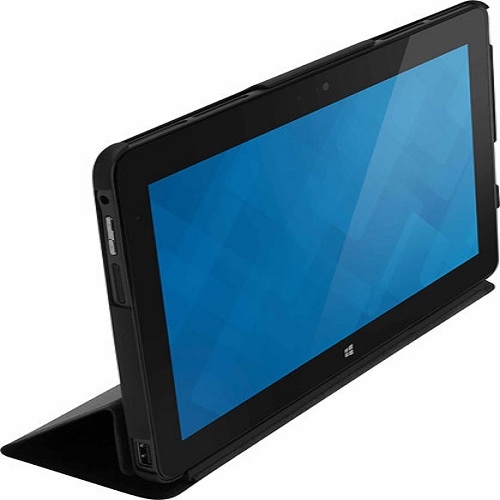
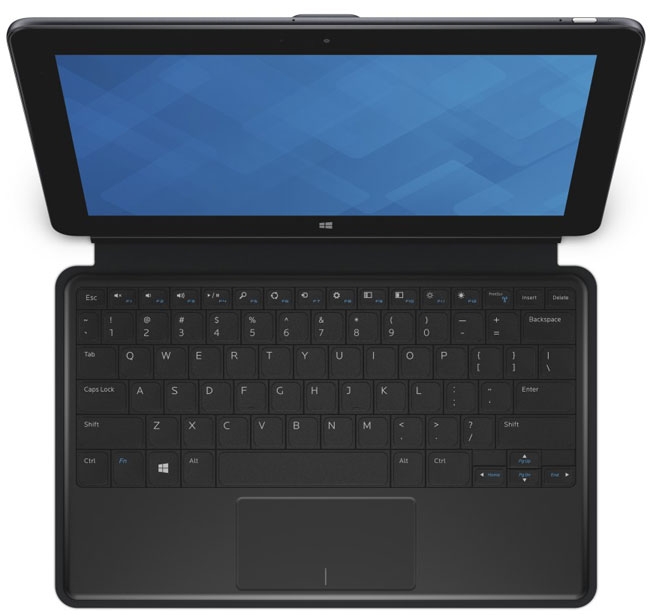
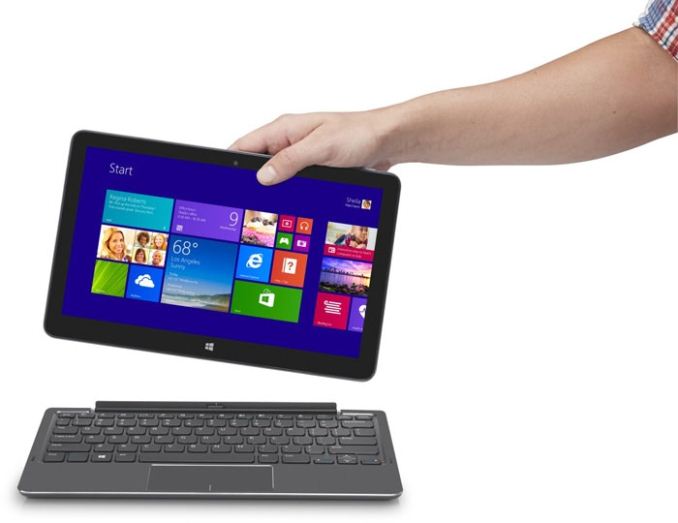
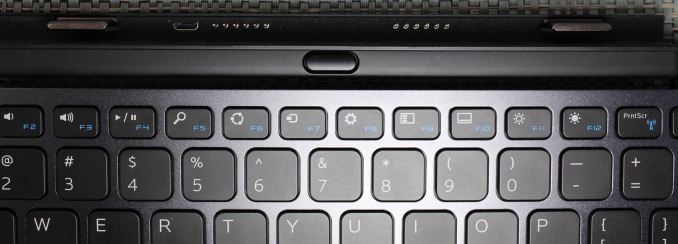

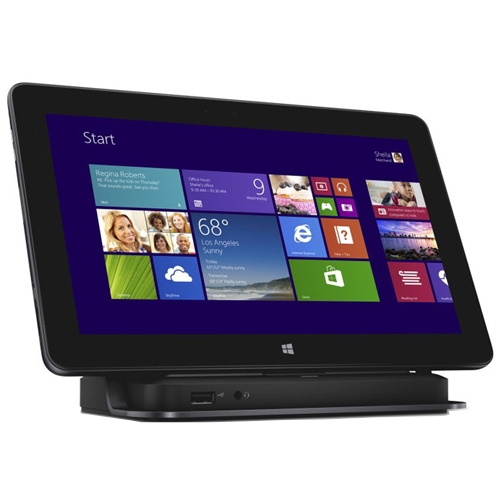








92 Comments
View All Comments
MrSpadge - Thursday, April 16, 2015 - link
Well Said! I'm not going to buy Core M because I value performance over mobility - yet this doesn't make it a bad product. If you want maximum performance at high mobility, nothing comes close to Core M.dj_aris - Thursday, April 16, 2015 - link
Core M is in fact a new cpu category on it's own, a cpu that resembles the single core performance of "core" cpus while in the Atoms' TDP envelope (at least before it throttles!). But, as with every new product, it's overpriced at launch. Wait for the Skylake release, I say.lilmoe - Thursday, April 16, 2015 - link
That's the main point. It's REALLY overpriced.xthetenth - Thursday, April 16, 2015 - link
Pay a pretty high price for the absolute best burst performance for a snappy device. I've heard much worse than that.smilingcrow - Thursday, April 16, 2015 - link
The M-5Y71 is the same price as the i5-4300U in my laptop with the same base & turbo boost clocks for the CPU. Given the same cooling as my laptop has it should perform very similarly for CPU loads. Not fussed about GPU loads so haven't focussed on that but seemingly it will struggle to match the U series when both are stressed.Marc GP - Thursday, April 16, 2015 - link
A category where they can only keep this performance for short bursts before having to low their frequency from 2,8Ghz (turbo) to their nominal 1Ghz (where you don't get any much performance than on a simple Atom).ppi - Thursday, April 16, 2015 - link
Even in the benchmarks, where sustained performance is necessary, Core-M is some 25% slower compared to 15W Broadwell. ONLY.This effectively means, that if task is pain on Core-M, it will be pain on 15W Broadwell as well. I.e. if some task is not snappy and requires waiting on Core-M, it requires waiting on Broadwell as well. And only desktop class chips may have the oomph to be significantly faster.
I do not count in games, but nobody considers Broadwell-U gaming SoC either.
smilingcrow - Thursday, April 16, 2015 - link
If you had read the recent detailed Anandtech overview of Core M you would see that is a fallacy. I was surprised how well Core M does in a fanless laptop versus one with a Broadwell i5 that is fan cooled. And even more how well it does in a tablet where surface temperate is more of an issue so throttling is more prevalent.A Core M-5Y71 in my Latitude E7440 with a slightly beefier cooler would I imagine come close to my i5-4300U even for extended loads. This is purely for CPU loads as the GPU is another issue that doesn’t concern me.
MrSpadge - Thursday, April 16, 2015 - link
When it throttles it's actually entering Atoms TDP envelope. Before that it's allowed to use more power for short periods. That's the whole point of a Thermal Design Power.zepi - Thursday, April 16, 2015 - link
If you don't care about absolute performance, Intel is happy to sell you a Baytrail for quite a bit cheaper.If you do... Well, no one else can match Core M's CPU-performance even remotely.